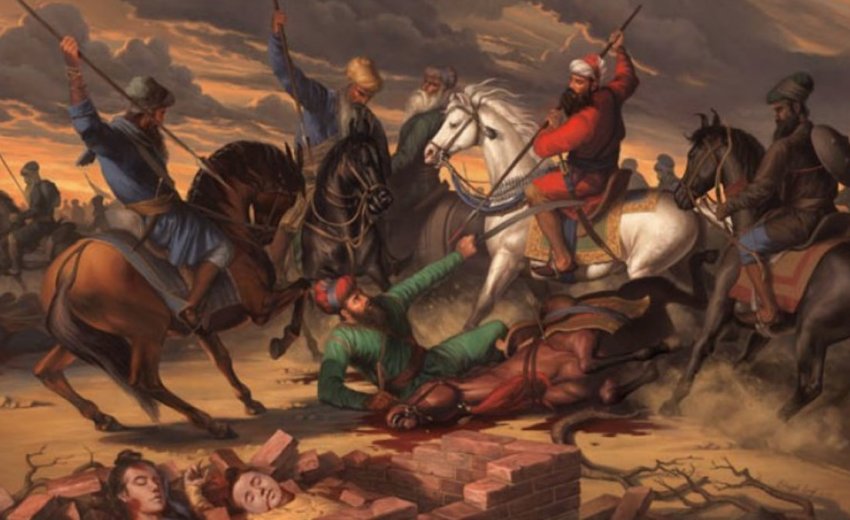Banda Singh Bahadur was once a Bairagi militant Sadhu, but history paints him as a converted Sikh fueled by the strength and motivation bestowed upon him by Guru Gobind Singh Ji
Banda Bahadur, a courageous Sikh warrior, achieved a significant triumph against Nawab Wazir Khan, the Governor of Sirhind. Khan had cruelly bricked two younger Sahibzadas of Guru Gobind Singh Ji, evoking a poignant memory. Banda Bahadur, originally a Sikh Bairagi, transformed into a soldier and led a seven-year struggle from 1709 to 1716. His efforts established Khalsa rule in Punjab, overthrowing the Mughal rule.
Who was Banda Singh Bahadur?
Banda Singh Bahadur was once a Bairagi militant Sadhu, but history paints him as a converted Sikh fueled by the strength and motivation bestowed upon him by Guru Gobind Singh Ji. Picture this: a dedicated group of 26, led by this transformed Sikh, embarking on a 1600-mile journey with a mission. Their goal wasn't conquest, but to free the peasants from the oppressive rule of the Mughal infidels. Armed with only the Guru's five arrows, a Nishan Sahib (flag), and a Nagara (war drum), these symbols represented their authority from the Tenth Guru. It may sound like a fairy tale in today's world, but this incredible story tells of a remarkable journey to liberate the oppressed.
His background
Banda Singh Bahadur, originally named Madho Das, hailed from the Jammu hills and began his life as a skilled hunter. Back then, hunting relied on intense practical training and the art of stealthily tracking wild animals, honed through years of hard work, mental sharpness, and a wily instinct. Madho Das, a natural hunter, underwent a transformation to become a Sadhu after a distressing incident involving the killing of a pregnant deer.
Recognizing his inherent traits, Guru Gobind Singh Ji saw potential in Madho Das. He inspired the former Bairagi to channel his hunting skills towards confronting the oppressive Mughals, who were inflicting atrocities upon humanity, especially upon the Sikh community in Punjab. This led to Madho Das, now Banda Singh Bahadur, taking on the task of vanquishing the Mughals and seeking justice for their wrongdoings.
Crumbling the Mughal Empire: Banda's Masterplan
Banda's strategy in was to safely reach Punjab, gather a group of volunteers, quickly arm and train them, and then use a tactic called the "Crumbling Process." This tactic involved gradually attacking the powerful Mughal administrative centers one by one. Banda wanted to punish the Mughals for committing crimes against his people.
During his almost year-long journey from Nanded to Punjab, Banda captured Mughal strongholds like SAMANA, GHURAM, THASKA, MUSTAFABAD, and SADHAURA, progressing until he reached the outskirts of SIRHIND. His main goal was to seek revenge for the brutal torture and killing of the brave and innocent SAHIBZADAS.
Banda Bahadur was a master strategist in war. He had a few key tricks up his sleeve: surprise attacks, being adaptable on the battlefield, taking the offensive stance, and focusing forces on one area to gain an advantage. He used these tactics flawlessly to conquer one garrison after another. Even writers from the Muslim community couldn't help but acknowledge the remarkable fighting skills of the Sikh soldiers under his leadership. Although it's hard to cover Banda Bahadur's entire campaign in a magazine article, highlighting his exceptional strategies with specific examples would be a great way to showcase his brilliance.
The Capture of Samana
SAMANA was like a fortress, with walls surrounding it and every building was fortified. The Mughal force defending it was strong, armed with guns to protect the town. On November 26, 1709,Banda Bahadur, executed a clever plan: he pretended to stay at a distance the day before, making the defenders think he wasn't planning to attack. However, that night, his Sikh force swiftly approached from several miles away, entering the town from all sides before the gates could be shut. They met little resistance and by the next night, SAMANA was completely captured and sacked. Banda Bahadur's strategy was brilliant, focusing on surprise, quick movement, and minimizing casualties – the key principles of successful warfare.
Remembering the Fallen and Punishing the Tyrants:The Battle Of Chappar Chiri
Sirhind was the main town in Southeast Punjab, and it held a dark reputation among Sikhs because of the cruelty of its governor, Wazir Khan. Banda Bahadur, a leader of the Sikhs, aimed to hold Khan accountable for his brutal actions. The British historian James Brown called Khan's deeds barbaric, fueling the Sikhs' desire for justice. Khan, aware of this brewing anger, sent a strong force led by Sher Mohammed Khan of Malerkotla to stop a large group of Sikhs from joining Banda Bahadur's main force.
Despite the odds, the valiant Sikhs triumphed after a fierce battle against Sher Mohammed Khan's force near Ropar. Banda successfully gathered his troops for the ultimate showdown. Like Napoleon, Banda observed the battlefield strategically from a high point, keeping an elite reserve prepared for a decisive strike at the weakest spot.
At Chappar Chiri, the Mughals outnumbered Banda's forces and had superior weapons, but Banda's soldiers, armed with spears, arrows, swords, and immense courage, persevered. Despite initial losses, Banda launched his elite troops at a critical moment, breaking through the Mughal lines on the wide plains of Chappar Chiri. The battle was intense, with Khafi Khan describing how Mughal horses and elephants fell to the Sikhs, who pursued the enemy as far as Sirhind. Wazir Khan himself was captured alive but later met his end, and the Mughal army was utterly defeated.
Banda Bahadur mourned the loss of around 5000 soldiers, honoring them with last rites before entering Sirhind. Wazir Khan's fate was sealed as his body hung upside down from a significant tree, serving as a grim reminder of the destiny awaiting tyrants.
Adaptability and Brilliance: A Commander Beyond Compare
Banda Bahadur was smart about when to engage Wazir Khan's Army. Instead of attacking right away, he waited until he could join forces with the Khalsa reinforcements from Majha and Doaba. Despite knowing the enemy was gearing up defenses at Chapper Chiri, he strategically positioned his troops behind hills and trees to shield them from enemy artillery.
As the situation changed and surprise shattered, Banda Singh Bahadur knew brute force wouldn't prevail.But Banda, the lion of the Khalsa, was not one to be cowed. He adapted. Rather than facing the Mughal Army head-on, which would've been disastrous due to their heavy firepower.Under the cloak of night, his commandos infiltrated the Mughal camp, silencing the artillery batteries that rained destruction upon his men. Once done, his hidden archers and musketeers inflicted significant losses on the enemy cavalry, sending elephants into a frenzied stampede. The chaos allowed his cavalry to attack from the sides and back, while his foot soldiers launched frontal assaults at dawn. Although they faced casualties due to the Mughal firepower, Banda had a plan.
This was Banda's moment. From his vantage point, atop a towering hillock, he surveyed the battlefield, and then made his move. Banda led a decisive strike right into the heart of the Mughal forces. The Sikhs, skilled in close combat, capitalized on the break in the enemy lines, leading to an unstoppable offensive. It was an exceptional victory, a testament to Banda's strategic brilliance and adherence to sound military principles.
Banda successfully sought revenge for the tragic fate of the Sahibzadas, who were bricked alive. This heroic act declared them martyrs. The Khalsa roared their victory across the land, a fitting climax to the Guru's mission. A deserving memorial should be erected at Chappar Chiri to honor this exceptional Sikh leader, a beacon of Sikh valor for ages to come!
*Based on an article by Lt.Gen.Kartar Singh Gill, published in emgonline.com on 2nd April 2010

